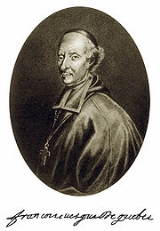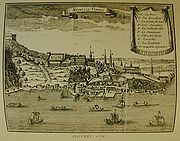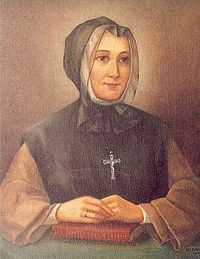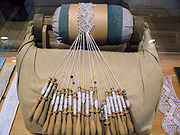
Ursulines of Quebec
Encyclopedia
The Ursuline Convent of Quebec City, (French: Couvent Ursulines), founded in 1639, is the oldest institution of learning for women in North America. Today, the convent operates an historical museum and teaching centre.
The complex was designated a National Historic Site of Canada in 1972.
are a Roman Catholic (Christian
) religious order founded at Brescia
, Italy by Saint Angela de Merici in 1535, primarily for the education of girls and the care of the sick and needy. Their patron saint is Saint Ursula
.
The Viceroyalty of New France
was the area colonized by France in North America starting with the exploration of the Saint Lawrence River
by Jacques Cartier
in 1534. The French explorer Samuel de Champlain
founded the city of Québec
in 1608 among the Algonquin people as the administrative seat for New France. Colonization was slow and difficult. Many settlers died early, because of harsh weather and diseases. In 1630, there were only 103 colonists living in the settlement, but, by 1640, there were 355.
 The history of the Ursulines in Quebec begins on 1 August 1639, when its first members landed in Canada
The history of the Ursulines in Quebec begins on 1 August 1639, when its first members landed in Canada
. The convent was established by Marie de l'Incarnation (1599–1672), an Ursuline nun, and Madame Marie-Madeline de Chauvigny de la Peltrie
(1603–1671), a rich widow from Alençon
in Normandy
. The letters royal sanctioning the foundation are dated 1639.
After three years spent in the Lower Town of Quebec City
, the nuns moved to the convent built on the ground they still occupy, ceded to them by the Company of New France. Their first pupils were Indian girls, with whom they succeeded better than the Jesuits with their native boys. The first convent was burned in 1650, but was soon rebuilt.
The Constitutions, written by Father Jérôme Lalemant
(1593–1673), uncle of the Jesuit martyr Gabriel Lalemant, combined the rules of the two Congregations of Paris and Bordeaux, and were observed until Bishop François de Laval
decided in 1681 in favor of the former, which binds its members by a fourth vow to teach girls.
Marie de l'Incarnation, the foundress, practiced devotion to the Sacred Heart of Jesus, and had established it in the cloister years before the revelation to the blessed Margaret Mary
(1647–1690). The first celebration of the feast in the New World took place in the monastery 18 June 1700. The register of the Confraternity of the Sacred Heart begins in 1716. Pope Clement XI
(1718) enriched it with indulgences.
The convent was threatened by the Iroquois
in 1661-2, when one of its chaplains, the Sulpician Vignal, was slain and devoured near Montreal
.
 The convent underwent the siege and bombardment of Quebec
The convent underwent the siege and bombardment of Quebec
by Phips
in 1690, and a second siege by Wolfe
in 1759. After the battle of 13 September 1759
, where the garrison of Quebec was defeated by Wolfe's army, the French governor, Montcalm
, was buried by night in the convent chapel. The first English governor, Murray, used part of the monastery as his headquarters. On that occasion the rations served to the nuns for nursing the wounded and sick saved them from perishing of starvation. The governors and viceroys, both English and French, were always friendly to the institution.
The Quebec convent founded convents at Three Rivers
in 1697, Roberval
in 1882, Stanstead in 1884, and Rimouski, with a normal school, in 1906, besides sending missionaries to New Orleans in 1822, Charlestown (Boston) in 1824, Galveston in 1849 and Montana in 1893.
 The foundress, Marie de l'Incarnation mastered the local languages and composed dictionaries in Algonquin
The foundress, Marie de l'Incarnation mastered the local languages and composed dictionaries in Algonquin
and Iroquois
, a sacred history in Algonquin, and a catechism in Iroquois.
The first superior elected (1760) after the conquest was Esther Wheelwright, a New England captive, rescued from the Abenakis by the Jesuit Bigot, and a protégée of the first governor, Vaudreuil
. The Irish, Scottish and American elements in Canada have given distinguished subjects to this cloister, prominent among whom was mother Cecilia O'Conway of the Incarnation, the first Philadelphia nun, one of Mother Seton's
earliest associates. The list of alumnae includes Jeanne Le Ber
(1662–1714)), the saintly "recluse of Montreal", and Venerable Mother D'Youville
(1701–1771), foundress of the Grey Sisters at Montreal.
During the French Revolution
(1789–1799) several French refugees were chaplains to the monastery, the most notable being Abbé L.P. Desjardins, who died in France, Vicar-General of Paris. Through him were procured the valuable paintings by Philippe de Champaigne
, Charles Le Brun
, Hyacinthe Collin de Vermont
, Pietro da Cortona
and others, that adorn the chapel.
 The convent has many of its original walls intact and houses a little chapel and a museum. It is located at 12 Rue Donnacona in the middle of the historical district of Quebec City, which is recognized by UNESCO
The convent has many of its original walls intact and houses a little chapel and a museum. It is located at 12 Rue Donnacona in the middle of the historical district of Quebec City, which is recognized by UNESCO
as a World Heritage District. The associated school
has two campuses. In the Quebec City campus, there are more than four hundred girls enrolled from pre-school through primary school (5 to 12 years). There is also a coeducational campus in Loretteville.
, CHIN
and Virtual Museum of Canada
.
The complex was designated a National Historic Site of Canada in 1972.
Background
The UrsulinesUrsulines
The Ursulines are a Roman Catholic religious order for women founded at Brescia, Italy, by Saint Angela de Merici in November 1535, primarily for the education of girls and the care of the sick and needy. Their patron saint is Saint Ursula.-History:St Angela de Merici spent 17 years leading a...
are a Roman Catholic (Christian
Christian
A Christian is a person who adheres to Christianity, an Abrahamic, monotheistic religion based on the life and teachings of Jesus of Nazareth as recorded in the Canonical gospels and the letters of the New Testament...
) religious order founded at Brescia
Brescia
Brescia is a city and comune in the region of Lombardy in northern Italy. It is situated at the foot of the Alps, between the Mella and the Naviglio, with a population of around 197,000. It is the second largest city in Lombardy, after the capital, Milan...
, Italy by Saint Angela de Merici in 1535, primarily for the education of girls and the care of the sick and needy. Their patron saint is Saint Ursula
Saint Ursula
Saint Ursula is a British Christian saint. Her feast day in the extraordinary form calendar of the Catholic Church is October 21...
.
The Viceroyalty of New France
New France
New France was the area colonized by France in North America during a period beginning with the exploration of the Saint Lawrence River by Jacques Cartier in 1534 and ending with the cession of New France to Spain and Great Britain in 1763...
was the area colonized by France in North America starting with the exploration of the Saint Lawrence River
Saint Lawrence River
The Saint Lawrence is a large river flowing approximately from southwest to northeast in the middle latitudes of North America, connecting the Great Lakes with the Atlantic Ocean. It is the primary drainage conveyor of the Great Lakes Basin...
by Jacques Cartier
Jacques Cartier
Jacques Cartier was a French explorer of Breton origin who claimed what is now Canada for France. He was the first European to describe and map the Gulf of Saint Lawrence and the shores of the Saint Lawrence River, which he named "The Country of Canadas", after the Iroquois names for the two big...
in 1534. The French explorer Samuel de Champlain
Samuel de Champlain
Samuel de Champlain , "The Father of New France", was a French navigator, cartographer, draughtsman, soldier, explorer, geographer, ethnologist, diplomat, and chronicler. He founded New France and Quebec City on July 3, 1608....
founded the city of Québec
Quebec City
Quebec , also Québec, Quebec City or Québec City is the capital of the Canadian province of Quebec and is located within the Capitale-Nationale region. It is the second most populous city in Quebec after Montreal, which is about to the southwest...
in 1608 among the Algonquin people as the administrative seat for New France. Colonization was slow and difficult. Many settlers died early, because of harsh weather and diseases. In 1630, there were only 103 colonists living in the settlement, but, by 1640, there were 355.
History

Canada
Canada is a North American country consisting of ten provinces and three territories. Located in the northern part of the continent, it extends from the Atlantic Ocean in the east to the Pacific Ocean in the west, and northward into the Arctic Ocean...
. The convent was established by Marie de l'Incarnation (1599–1672), an Ursuline nun, and Madame Marie-Madeline de Chauvigny de la Peltrie
Marie-Madeline de Chauvigny de la Peltrie
Marie-Madeleine de Chauvigny de la Peltrie was a French woman who started the Order of Ursulines of Quebec.Madame Chauvigny was born at Alençon. She arrived in New France with a number of Ursulines including a future nun, Charlotte Barré and Marie de l'Incarnation, who was to be the religious...
(1603–1671), a rich widow from Alençon
Alençon
Alençon is a commune in Normandy, France, capital of the Orne department. It is situated west of Paris. Alençon belongs to the intercommunality of Alençon .-History:...
in Normandy
Normandy
Normandy is a geographical region corresponding to the former Duchy of Normandy. It is in France.The continental territory covers 30,627 km² and forms the preponderant part of Normandy and roughly 5% of the territory of France. It is divided for administrative purposes into two régions:...
. The letters royal sanctioning the foundation are dated 1639.
After three years spent in the Lower Town of Quebec City
Quebec City
Quebec , also Québec, Quebec City or Québec City is the capital of the Canadian province of Quebec and is located within the Capitale-Nationale region. It is the second most populous city in Quebec after Montreal, which is about to the southwest...
, the nuns moved to the convent built on the ground they still occupy, ceded to them by the Company of New France. Their first pupils were Indian girls, with whom they succeeded better than the Jesuits with their native boys. The first convent was burned in 1650, but was soon rebuilt.
The Constitutions, written by Father Jérôme Lalemant
Jérôme Lalemant
Jérôme Lalemant was a Jesuit priest who came to Canada in 1638 after much varied experience in the priesthood in France. He was almost immediately made superior for the mission to the Hurons, succeeding Jean de Brébeuf, and in 1639 founded Sainte-Marie-des-Hurons which was the central residence...
(1593–1673), uncle of the Jesuit martyr Gabriel Lalemant, combined the rules of the two Congregations of Paris and Bordeaux, and were observed until Bishop François de Laval
François de Laval
This article is in part a sermon and generally comes close to hagiography.Blessed François-Xavier de Montmorency-Laval was the first Roman Catholic bishop of Quebec and was one of the most influential men of his day. He was appointed when he was 36 years old by Pope Alexander VII. He was a member...
decided in 1681 in favor of the former, which binds its members by a fourth vow to teach girls.
Marie de l'Incarnation, the foundress, practiced devotion to the Sacred Heart of Jesus, and had established it in the cloister years before the revelation to the blessed Margaret Mary
Marguerite Marie Alacoque
Marguerite Marie Alacoque or Saint Margaret Mary Alacoque was a French Roman Catholic nun and mystic, who promoted devotion to the Sacred Heart of Jesus in its modern form.-Early life:...
(1647–1690). The first celebration of the feast in the New World took place in the monastery 18 June 1700. The register of the Confraternity of the Sacred Heart begins in 1716. Pope Clement XI
Pope Clement XI
Pope Clement XI , born Giovanni Francesco Albani, was Pope from 1700 until his death in 1721.-Early life:...
(1718) enriched it with indulgences.
The convent was threatened by the Iroquois
Iroquois
The Iroquois , also known as the Haudenosaunee or the "People of the Longhouse", are an association of several tribes of indigenous people of North America...
in 1661-2, when one of its chaplains, the Sulpician Vignal, was slain and devoured near Montreal
Montreal
Montreal is a city in Canada. It is the largest city in the province of Quebec, the second-largest city in Canada and the seventh largest in North America...
.

Battle of Quebec (1690)
The Battle of Quebec was fought in October 1690 between the colonies of New France and Massachusetts Bay, then ruled by the kingdoms of France and England, respectively. It was the first time Quebec's defences were tested....
by Phips
William Phips
Sir William Phips was a shipwright, ship's captain, treasure hunter, military leader, and the first royally-appointed governor of the Province of Massachusetts Bay....
in 1690, and a second siege by Wolfe
James Wolfe
Major General James P. Wolfe was a British Army officer, known for his training reforms but remembered chiefly for his victory over the French in Canada...
in 1759. After the battle of 13 September 1759
Battle of the Plains of Abraham
The Battle of the Plains of Abraham, also known as the Battle of Quebec, was a pivotal battle in the Seven Years' War...
, where the garrison of Quebec was defeated by Wolfe's army, the French governor, Montcalm
Louis-Joseph de Montcalm
Louis-Joseph de Montcalm-Gozon, Marquis de Saint-Veran was a French soldier best known as the commander of the forces in North America during the Seven Years' War .Montcalm was born near Nîmes in France to a noble family, and entered military service...
, was buried by night in the convent chapel. The first English governor, Murray, used part of the monastery as his headquarters. On that occasion the rations served to the nuns for nursing the wounded and sick saved them from perishing of starvation. The governors and viceroys, both English and French, were always friendly to the institution.
The Quebec convent founded convents at Three Rivers
Trois-Rivières
Trois-Rivières means three rivers in French and may refer to:in Canada*Trois-Rivières, the largest city in the Mauricie region of Quebec, Canada*Circuit Trois-Rivières, a racetrack in Trois-Rivières, Quebec...
in 1697, Roberval
Roberval, Quebec
Roberval is a city on the south-western shore of Lac Saint-Jean in the Le Domaine-du-Roy Regional County Municipality of Quebec, Canada. With a population of 10,544 in the Canada 2006 Census, it is the third largest city on this lake after Alma and Dolbeau-Mistassini.It is the seat of the...
in 1882, Stanstead in 1884, and Rimouski, with a normal school, in 1906, besides sending missionaries to New Orleans in 1822, Charlestown (Boston) in 1824, Galveston in 1849 and Montana in 1893.
Notable people

Algonquin language
Algonquin is either a distinct Algonquian language closely related to the Ojibwe language or a particularly divergent Ojibwe dialect. It is spoken, alongside French and to some extent English, by the Algonquin First Nations of Quebec and Ontario...
and Iroquois
Iroquois
The Iroquois , also known as the Haudenosaunee or the "People of the Longhouse", are an association of several tribes of indigenous people of North America...
, a sacred history in Algonquin, and a catechism in Iroquois.
The first superior elected (1760) after the conquest was Esther Wheelwright, a New England captive, rescued from the Abenakis by the Jesuit Bigot, and a protégée of the first governor, Vaudreuil
Pierre François de Rigaud, Marquis de Vaudreuil-Cavagnal
Pierre François de Rigaud, Marquis de Vaudreuil-Cavagnal was a Canadian-born French colonial governor in North America...
. The Irish, Scottish and American elements in Canada have given distinguished subjects to this cloister, prominent among whom was mother Cecilia O'Conway of the Incarnation, the first Philadelphia nun, one of Mother Seton's
Elizabeth Ann Seton
Saint Elizabeth Ann Bayley Seton was the first native-born citizen of the United States to be canonized by the Roman Catholic Church . She established Catholic communities in Emmitsburg, Maryland....
earliest associates. The list of alumnae includes Jeanne Le Ber
Jeanne Le Ber
Jeanne Le Ber was a religious recluse in New France.- Family and Education :As a daughter of Jeanne Le Moyne and Jacques le Ber, Jeanne was raised within a wealthy and influential family; her mother was a sister of Charles le Moyne...
(1662–1714)), the saintly "recluse of Montreal", and Venerable Mother D'Youville
Marie-Marguerite d'Youville
Saint Marguerite d'Youville was a French Canadian widow who founded the religious order the Order of Sisters of Charity of Montreal, commonly known as the Grey Nuns of Montreal...
(1701–1771), foundress of the Grey Sisters at Montreal.
During the French Revolution
French Revolution
The French Revolution , sometimes distinguished as the 'Great French Revolution' , was a period of radical social and political upheaval in France and Europe. The absolute monarchy that had ruled France for centuries collapsed in three years...
(1789–1799) several French refugees were chaplains to the monastery, the most notable being Abbé L.P. Desjardins, who died in France, Vicar-General of Paris. Through him were procured the valuable paintings by Philippe de Champaigne
Philippe de Champaigne
Philippe de Champaigne was a Flemish-born French Baroque era painter, a major exponent of the French school.-Early life:Born in Brussels of a poor family, Champaigne was a pupil of the landscape painter Jacques Fouquières...
, Charles Le Brun
Charles Le Brun
Charles Le Brun , a French painter and art theorist, became the all-powerful, peerless master of 17th-century French art.-Biography:-Early life and training:...
, Hyacinthe Collin de Vermont
Hyacinthe Collin de Vermont
Hyacinthe Collin' de Vermont was a French painter.Collin de Vermont was a pupil of Jouvenet and of Rigaud.-Works:* Bacchus changes the Maenads' works into vine foliage, Musée de Versailles...
, Pietro da Cortona
Pietro da Cortona
Pietro da Cortona, by the name of Pietro Berrettini, born Pietro Berrettini da Cortona, was the leading Italian Baroque painter of his time and also one of the key architects in the emergence of Roman Baroque architecture. He was also an important decorator...
and others, that adorn the chapel.
Today

UNESCO
The United Nations Educational, Scientific and Cultural Organization is a specialized agency of the United Nations...
as a World Heritage District. The associated school
Ecole des Ursulines, Quebec
The Ecole des Ursulines, known in English as the School of the Ursulines, is among North America's oldest schools. Still operating as a private girls school, it was founded in 1639 by French nun Marie de l'Incarnation and laywoman Marie-Madeline de Chauvigny de la Peltrie...
has two campuses. In the Quebec City campus, there are more than four hundred girls enrolled from pre-school through primary school (5 to 12 years). There is also a coeducational campus in Loretteville.
Affiliations
The Museum is affiliated with: CMACanadian Museums Association
The Canadian Museums Association is a national organization for the promotion of museums in Canada.The Canadian Museums Association is the national organization for the advancement of the Canadian museum sector, representing Canadian museum professionals both within Canada and internationally. The...
, CHIN
Canadian Heritage Information Network
The Canadian Heritage Information Network is a Canadian government-supported organization that provides a networked interface to Canada's heritage, largely through the World Wide Web. It aims to give access to Canada's heritage for both Canadians and a worldwide audience, by supporting the...
and Virtual Museum of Canada
Virtual Museum of Canada
The Virtual Museum of Canada is Canada's national virtual museum. With a directory of over 3,000 Canadian heritage institutions and a database of over 600 virtual exhibits, the VMC brings together Canada's museums regardless of size or geographical location.The VMC includes virtual exhibits,...
.

